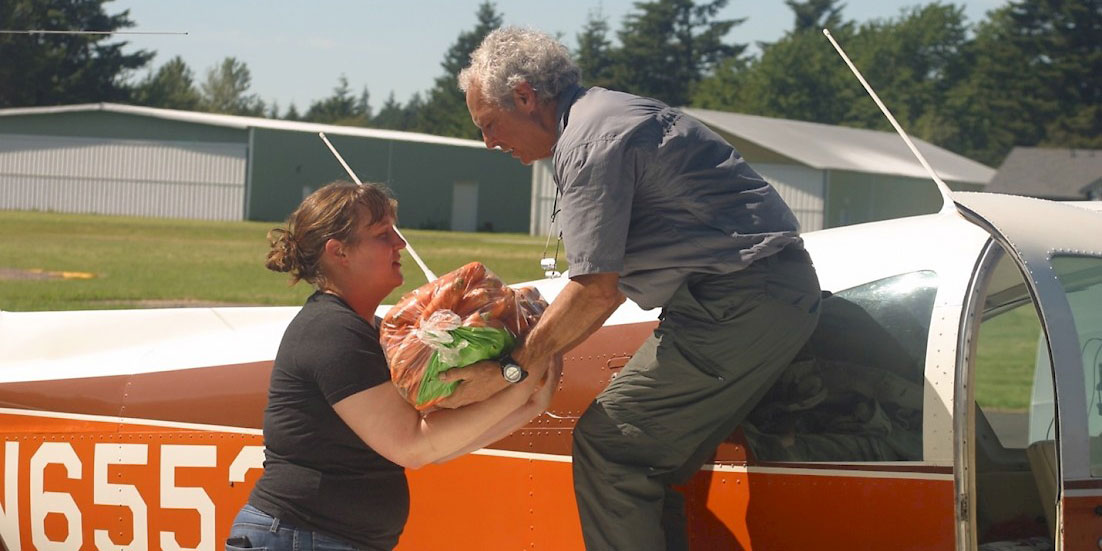- Articles, Communication & Interoperability, Critical Infrastructure, Emergency Management, Emergency Medical Services, Fire, Hazmat, Military, Public Health, Science & Technology, Transportation
- by: James Origliosso & Sky Terry
On June 18-21, 2022, the West Coast General Aviation Response Plan (WCGARP) was initiated for a full-scale, multi-agency, multi-jurisdictional, all-day training exercise as a part of the National Level Exercise led by Tribal Nations in the Pacific Northwest. This exercise, originally named Cascadia Rising – and re-named the Thunderbird and Whale 2022 when the Tribes took the lead – incorporated the WCGARP as a two-part aviation response to an earthquake and tsunami incident.
Although the June exercise marked the first full-scale implementation of the WCGARP plan, pilots in the area had been preparing for that exercise for over a decade, beginning with a seaplane exercise at Lake Whatcom in 2009. Conducting land-based drills began with a joint effort in 2015 when a California Disaster Airlift Response Team (CalDART) pilot flew food from Bellingham International Airport direct to the San Francisco Bay area. This initiated an effort (by Sky Terry and Paul Marshall, who was the original developer of the DART concept) to bring the formal DART program to Washington. By 2018, pilots established the first official Washington DART in Clallam County. However, the past two years of progress are the most remarkable.
Over the past decade, general aviation pilots have made significant advances in preparing pilots and ground crews to respond to local disasters.
General Aviation Overview
The term “general aviation” refers to noncommercial pilots who voluntarily donate their time or aircraft to help move supplies or people as needed. Unlike commercial operators, who require different certifications, general aviation pilots cannot accept money for their time, fuel, or any other financial compensation. However, these pilots have the same rights to airports as commercial enterprises – like personal automobiles, emergency vehicles, and commercial trucks sharing the roadways. The only exception is small private airports, which require advance arrangements for accessibility.
To ensure safety, the Federal Aviation Administration sets general guidelines for airspace, with the Coast Guard having authority over seaplanes and waterways that border two or more states. However, most emergency coordination efforts involve key community stakeholders, including emergency management agencies, emergency medical services, Tribal leadership, amateur radio operators, Civil Air Patrol, and groups like Miracle Food Network, which help move the food from the airport to the final destination.
2020 – Developing the Plan
To address the Cascadia earthquake scenario, many people (including Sky Terry, Rol Murrow from Emergency Volunteer Air Corps (EVAC), Paul Marshall from CalDART, Alan Barnard from Clallam County DART) provided tremendous input and guidance to create the WCGARP in May 2020. The plan aims to make a coordinated response effort that links national efforts with local pilots. For example, in a disaster, response agencies would collaborate with general aviation pilots to fly resources into the damaged West Coast states and, on return legs, fly injured or displaced people out of the affected areas. The EVAC and Air Care Alliance are the primary leads and central clearing house.
In May 2020, pilots were already assisting with the COVID-19 response by flying face shields and other personal protective equipment (PPE) to area hospitals and flying abandoned dogs from Mexico to Washington to rehome them. May 9, 2020, was the first full use of WCGARP when CalDART – assisted by EVAC, Walla Walla Emergency Management, and Walla Walla DART – delivered 500 face shields to Walla Walla’s medical front-line workers.
In September 2020, the Whatcom County EVAC DART hosted an annual multi-county DART exercise, including a successful test of two-way radio communications with “impacted sites” in Washington. During that exercise, general aviation pilots flew 400 lb of donated food to Point Roberts for delivery to the local food bank. Adding to the realism of the activity, COVID-19 border restrictions between the U.S. and Canada at that time had already isolated Point Roberts from any land-based access to the U.S.
The remainder of 2020 gave general aviation pilots many ways to assist with the COVID-19 response and other humanitarian aid by delivering tens of thousands of masks, additional PPE, and food to those in need. Despite less-than-ideal weather conditions on some flight days, no injuries or mishaps occurred.
Since December 2020, general aviation pilots in the Northwest have been developing relationships with the National Tribal Emergency Management Council (NTEMC), Farmer Frog, and multiple aviation and emergency management leadership from California, Oregon, Washington, and Idaho. The initial discussion in December focused on transporting 125 pallets of PPE across Washington – ground shipment from Monroe to Arlington Airport – followed by flights to three other states (California, Oregon, and Idaho). The first airlift occurred in January 2021 with the transport of nearly 30,000 lbs of food and face masks. Since then, this expanding effort has been bringing together volunteer DART pilots and other organizations to provide emergency and disaster support to their local communities.
2021 – Exercising the Plan
Many experts have predicted that it is only a matter of time before the coast along the Cascadia Subduction Zone (i.e., the northern part of California, Oregon, Washington, and Vancouver, Canada) is impacted by a massive 9-magnitude or greater earthquake. When that day comes, general aviation may become the primary lifeline for transporting food, supplies, and people to and from disaster-struck areas. Training exercises help pilots, ground crews, and other participants understand their critical roles and responsibilities and help identify and close gaps that could hinder response efforts.
The first ever full-scale joint exercise where the northwest region’s DARTs and Civil Air Patrol participated with amateur radio operators and many other local, state, and federal representatives, took place in June 2021. Although local and state emergency response agencies had been training annually for this event, the COVID-19 pandemic demonstrated the need to include air support resources in the training process. That exercise involved many drills occurring concurrently with interlocking responses and multiple flights.
A critical step in protecting vital mobility transport in the early days after a catastrophic event involves assessments of roadways, fuel supply lines, and potential landing sites on land and water. The 2021 exercise revealed a few planning gaps to consider for future high-magnitude earthquakes in the Cascadia region:
- Supply lines for aviation may need to shift on both the west side and east side of the Cascadias;
- Multi-airport relays may be required;
- The location of seaplanes is critical for minimizing potential damage to the aircraft;
- The potential damages to roadways may leave general aviation as the only immediate way to access some affected areas; and
- The ability of general aviation to use waterways could make it one of the very first resources available (see a video of the Point Roberts seaplane operations).
During the June 2021 exercise and others since then, general aviation pilots, DARTs, the members of the WCGARP effort, and many other volunteers have been taking significant steps to be trained and ready to help deliver lifesaving aid when needed (e.g., transport of supplies and people, aerial damage assessments, communication links, etc.).
Call to Action
DARTs and other general aviation pilots can assist their communities significantly during local and regional disasters. And these efforts are not isolated to the United States. Similar efforts exist around the world – for example, in Papua New Guinea in September 2022, volunteer pilots provided disaster support to remote areas following a 7.6-magnitude earthquake.
To get started, emergency management and other response agencies should coordinate with general aviation pilots when developing local emergency response plans. Pilots also can join the EVAC, or they can create a DART anywhere by following a basic template.
This is Part 1 of a two-part article. Part 2 will share lessons learned from pilots during the 2022 Thunderbird and Whale Exercise. Find it HERE.

James Origliosso
Jim Origliosso, a licensed pilot with a commercial pilot certificate, has volunteered to organize the Oregon Disaster Airlift Response Team. He currently serves on the Board of Angel Flight West and is a retired Chief Financial Officer in the utility industry. He is also a licensed amateur radio operator.
-
James Origliossohttps://www.domesticpreparedness.com/author/james-origliosso
-
James Origliossohttps://www.domesticpreparedness.com/author/james-origliosso

Sky Terry
Sky Terry is a Licensed Practical Nurse (since 2011). Since shortly after the Nisqually Earthquake in Washington in 2001, he has been a primary leader in the development of general aviation (GA) as a critical response resource after the “big one.” His experience includes five years in the U.S. Army in communications with a secondary role as a combat lifesaver; three years as a volunteer firefighter at Mukilteo Fire Department and DuPont; two years as a nursing assistant; 14 years in search and rescue for Snohomish and Pierce Counties; and leader for multiple responses to the COVID pandemic in WA with GA resources. Additionally, since 2009, he has been the primary designer and organizer/leader for annual exercises in developing GA as a resource in WA (currently conducting two large-scale drills annually).
-
Sky Terryhttps://www.domesticpreparedness.com/author/sky-terry
-
Sky Terryhttps://www.domesticpreparedness.com/author/sky-terry
-
Sky Terryhttps://www.domesticpreparedness.com/author/sky-terry






